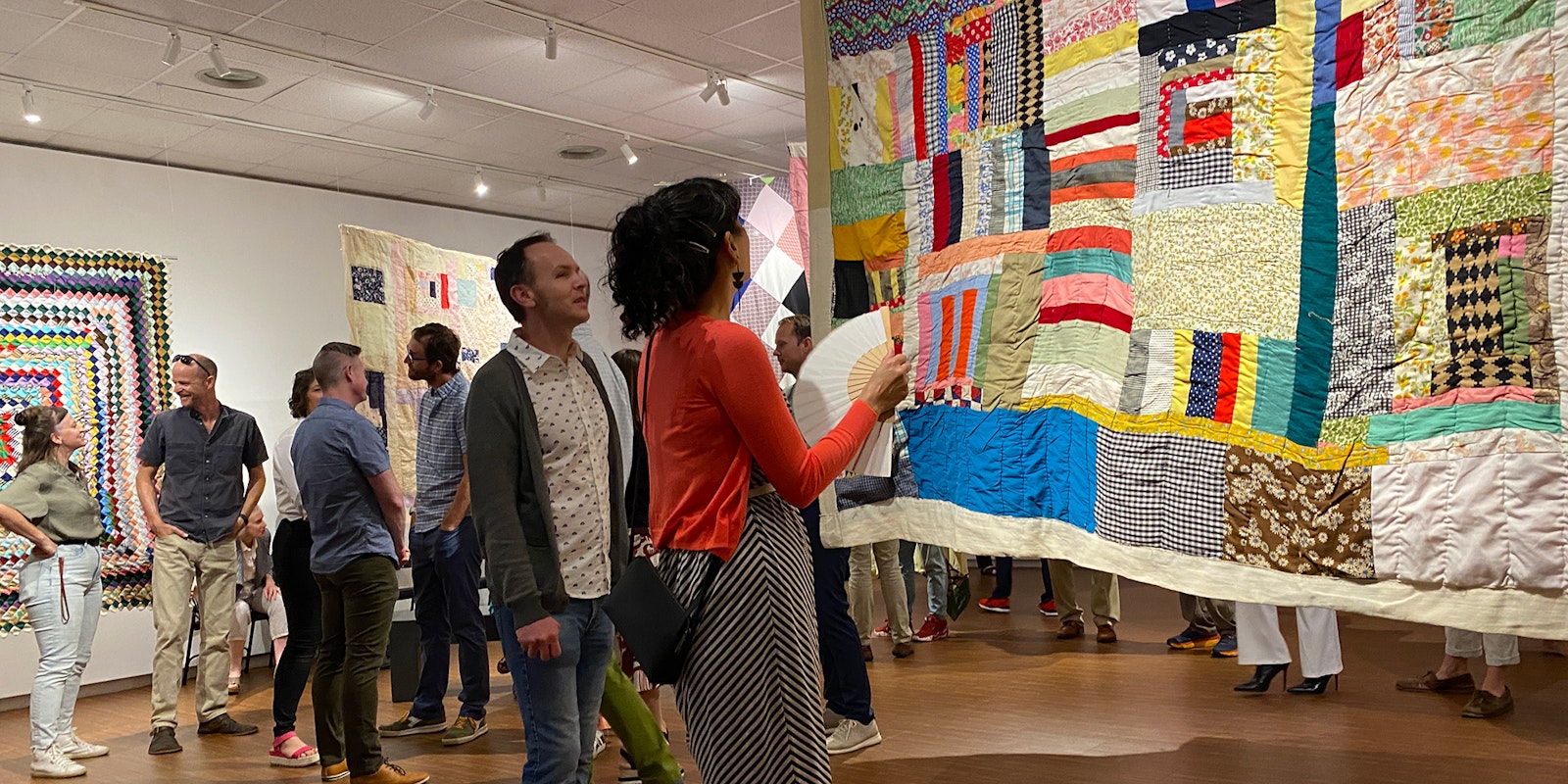The quilts hang from the ceiling, colorful and some so massive that I wonder how their maker used them. Fully covering a king bed, perhaps? Cloaking an entire wall? Mrs. Gussie Beatrice Arnold Hill designed her quilts to be functional, Anjali Austin explained at a reception celebrating her grandmother’s works at the Florida State University Museum of Fine Arts. Decades after the quilts’ construction, Austin works to discover the mysteries hidden in their fibers.
 The Quilts of Gussie Beatrice Arnold Hill presented by the Florida State University Museum of Fine Arts
The Quilts of Gussie Beatrice Arnold Hill presented by the Florida State University Museum of Fine Arts
The Exhibit
I gazed at the quilts for a wonderful thirty minutes before Austin began her presentation. Hill used a variety of techniques in her pieced quilts, from hand-quilting to machine sewing, tied layers to no backings at all. Light shined through these quilt tops, giving them a stained-glass-like appearance. Because the exhibitors had hung the quilts, we could (and did) examine them from the front and the back–Austin even explained that we could touch the textiles as long as we didn’t pull. A quilter’s dream!
Hill–an avid seamstress–assembled her quilts from an array of fabric shapes and sizes using leftover pieces from garment projects, piecing the irregular blocks into one finished, flowing piece. Some of her quilts had been painstakingly cut and assembled from small squares, sewn into lines more than 30 strong. Most came from everyday fabrics, but one shown in satin. Her relaxed style, eschewing straight lines and 90-degree corners, gave her quilts movement. The collection is beautiful.
“The quilts that Austin is showing are part of Tallahassee history,” says Meredith Lynn, Curator and Interim Director of the Florida State University Museum of Fine Art. “Often these familial histories are not shared with the public. We have a sense of public history, but we don’t necessarily have a great understanding of how historical events have impacted families because that information is oftentimes kept private.”
Moreover, Lynn wants the exhibit to showcase that art is quite literally all around us. “Art is something that happens in a lot of different ways,” she continues. “Art is something that your grandmother did in her home. It’s something that you do on a daily basis.”
Quilts as Connection
The exhibit ran from May 15-22 at the museum, the result of Austin’s research and artistic dedication to her grandmother’s legacy and, as the display explains: “to the brilliance of our ancestors–African Americans–who weathered the struggle with resilience and strength.” Austin lived with her grandmother until she was five, and research into the quilt and her family’s stories–as well as her experience as a professional dancer and dance professor at FSU–inspired her master’s thesis work and “Live Oak” performance that showcases these stories.
Her grandmother, Austin recalls during a portion of “Live Oak” that she performed at the reception, was born in Tallahassee in 1912. More than 30 quilts crafted during her lifetime now reside with Austin, in addition to one jumpsuit and one unfinished work. Austin wants to complete that fragment one day. Though she doesn’t quilt, yet, she is confident that she will as she forms deeper relationships with the quilts and the stories behind them.
 Close-up of one of Hill’s pieces presented by her granddaugther, Anjali Austin
Close-up of one of Hill’s pieces presented by her granddaugther, Anjali Austin
To Austin, the quilts connect her not only to her family, but to the legacy of African American quilters in the United States. During her talk, she noted that some patterns are consistent with research and studies conducted on quilts designed as maps to aid those traveling along the underground railroad.
“My drive is to recognize the depth and creativity of her work not only as a quilter,” Austin explains, “But on a larger scale as a contemporary artist.”
Into the Future
Austin’s work with Mrs. Gussie Beatrice Arnold Hill’s quilts is far from over. She plans to hire a fabric expert to discover what some of the stains and spots on the quilts might tell her about their use and about life in her grandmother’s house. She pointed to areas of the quilts that look ripped or worn and explained that lye soap had taken its toll on a few areas. Still, other signs of wear remain a mystery. Additionally, just knowing more about the types of fabrics incorporated into the quilts will help Austin construct a timeline of their creation.
As she said during her performance, the quilts “have a story to tell, but you gotta know how to read them.”
Austin hopes to continue sharing the quilts in exhibitions and performances in the future.
For more information on the work of Anjali Austin, click here.
Erika Zambello is a writer and communications specialist living in Florida. She is a fan of knitting on the move, especially during walks, hikes, and kayak trips. You can follow her fibercraft explorations at @knittingzdaily on Instagram.

